Bicycle Accidents
Check if Your Trek Bicycle Has Been Recalled

Nearly one million Trek bikes have been recalled after a cyclist was left paralyzed by an accident caused by a defective front disc brake.
About 900,000 bicycles in the U.S. and 98,000 bicycles in Canada were recalled recently by Trek Bicycle Corporation of Waterloo, Wisconsin. The recall involves bicycles sold nationwide from September 1999 through April 2015 for between $480 and $1,650.
Bicycles involved in the recall have a quick release lever on the bicycle’s front wheel hub that can come into contact with the front disc brake assembly, causing the front wheel to come to a sudden stop or separate from the bicycle, posing a risk of serious injury to the rider. Defective bicycles have a front quick release lever that expands beyond 180 degrees.
Trek issued the recall after reports of three injuries, including one person who suffered quadriplegia. A second person suffered facial injuries and another suffered a fractured wrist.
Consumers should stop using these Trek bicycles immediately. Call an authorized Trek retailer for a free inspection and installation of a new quick release on the front wheel of your bike. Trek is trying to encourage cyclists to seek the repair by offering a $20 coupon toward Bontrager merchandise.
Trek has not released a list of specific bicycle model numbers. Cyclists need to check their own bicycles and see if they are impacted by this recall. Some bicycles involved in this recall were purchased many years ago and owners may not have the original paperwork. Or you may have purchased one of these bicycles secondhand.
Do your due diligence and seek out a Massachusetts bicycle shop which sells Trek bicycles. Ask for a free inspection and have them make the free repair if needed.
Find a Trek bike dealer.
Read More
Free Bike Helmets for the Children at Framingham Earth Day Festival Last Weekend
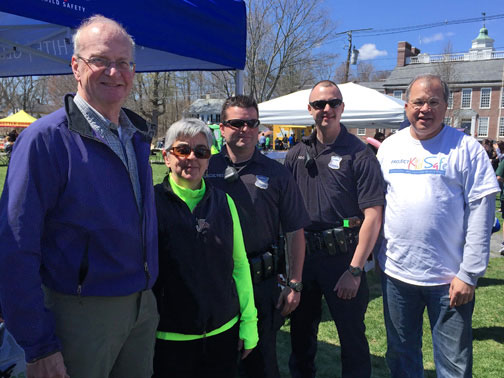
Photo left to right: Bill Hanson, chair of the Framingham Bicycle and Pedestrian Advisory Committee, volunteer Maura Kelly, Framingham police officers and Attorney David W. White of Breakstone, White & Gluck.
Breakstone, White & Gluck, the Framingham Bicycle and Pedestrian Advisory Committee, and the Framingham Police Department teamed up and gave away 120 bicycle helmets to children last weekend at the 5th Annual Framingham Earth Day Festival.
Breakstone, White & Gluck donated the helmets through our Project KidSafe initiative and attorney David W. White participated in the event, along with advisory committee members, including Bill Hanson, chair of the advisory committee, member Joseph Repoli, volunteer Maura Kelly and Framingham police officers.
Framingham Earth Day is held on the Framingham Centre Common and each year the event grows. It began in 2011 with 55 vendors encouraging residents to make eco-friendly choices. This year, nearly 100 vendors turned out. Breakstone, White & Gluck first participated in the festival last year.
Through our Project KidSafe initiative, Breakstone, White & Gluck has donated over 3,500 bicycle helmets to children in the Boston and Worcester areas. We expect to have donated more than 6,000 bicycle helmets by year’s end. Our goal is to encourage children to wear a bicycle helmet every time they ride.
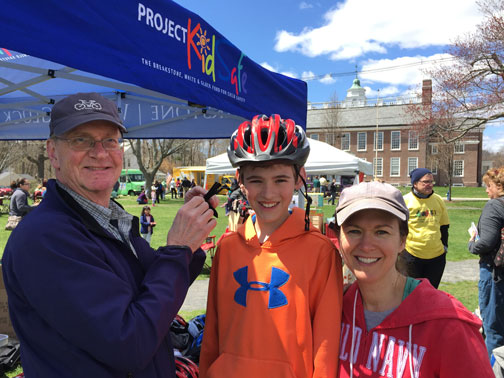
Cyclists of all ages should wear bicycle helmets to protect themselves from a serious head injury. But bicycle helmets are especially important for children, and they are required to wear them by law in Massachusetts.
Children suffer more than half of all bicycle-related injuries and deaths which require emergency department care each year, according to the Centers for Disease Control and Prevention (CDC). Some 26,000 of these bicycle-related injuries to children and teenagers are traumatic brain injuries treated in emergency rooms.
Watch this video on how to properly fit a bicycle helmet or visit our bike safety web page.
Read More
iCan Shine Bike Camp Teaches Bicycle Safety to Children and Teenagers with Disabilities
The iCan Shine bike camp is back in Arlington this week, teaching local children and teenagers with disabilities how to ride bicycles. iCan Shine is a national charitable nonprofit which provides cycling training for children and teenagers with autism, Down Syndrome and other disabilities. Breakstone, White & Gluck donated bicycle helmets to the camp for the second year and attorney Ronald Gluck visited with them this week.
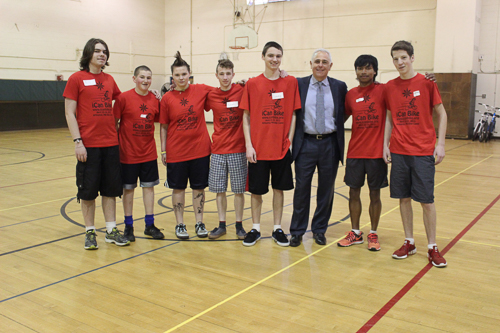
Photo: Attorney Ronald Gluck with the volunteers at the iCan Shine bike camp in Arlington, where Breakstone, White & Gluck donated bicycle helmets to the children and teenagers with disabilities who are learning to ride a bicycle this week. A few staffers from the national iCan Shine organization travel in to teach while local volunteers organize and fund-raise for the camp. Many volunteers also attend, giving their time to guide, steer and support the riders through each lesson.
Local communities throughout the U.S. coordinate these one-week camps and the national organization sends instructors with specialized training. The Pennsylvania organization, which was founded in 2007, serves nearly 3,000 people with disabilities each year. By the end of each five-day program, 80 percent of the bicyclists who attend an iCan Shine bike program are able to ride a two-wheel bicycle independently.
Arlington resident Nina Fischer brought the iCan Shine camp to Massachusetts in 2013, so her own daughter could learn how to ride a bicycle. She continues organizing and fund-raising for it each year. Other Massachusetts camps are now offered in Scituate, Groton and Upton. The Arlington camp was held this week at Ottoson Middle School on Acton Street, with help from volunteers. Each rider requires several volunteers to help steer, guide and direct. Volunteers included students who were on school vacation, longtime cyclists who wanted to help and town board members.
Attorney Ronald Gluck visited on “Tandem Tuesday,” when the students learn to ride on a tandem bicycle, with a trained instructor guiding them on back. This allows them to build strength and become more comfortable with riding.
“Seeing the smiling faces of these new bike riders as they rode around the gym was something to behold,” Attorney Gluck said. “It was a pleasure to visit.”
Breakstone, White & Gluck will donate more than 2,500 bicycle helmets to youth in Massachusetts this year through its Project KidSafe initiative. Our goal is to help educate children and families on the importance of wearing a bicycle helmet and how to properly wear one. This is the third year of our program and by year’s end, we will have donated more than 5,000 helmets to children to help them ride safely. To learn more, visit our Project KidSafe page or our bike safety page.
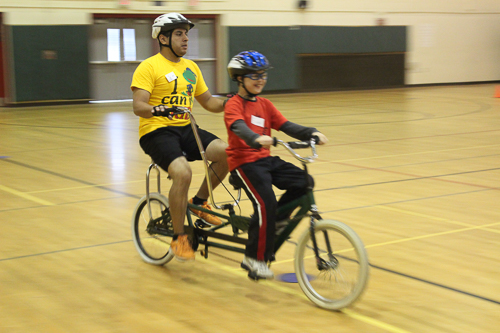
Instructor from the national iCan Shine organization riding on a tandem bicycle with a student at the Arlington iCan Shine bike camp.
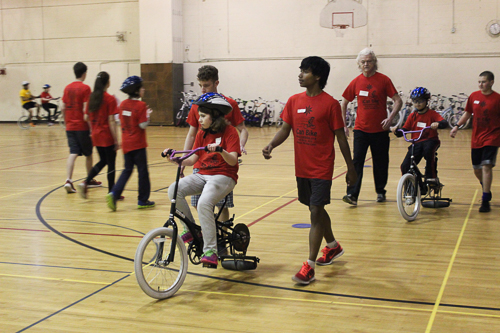
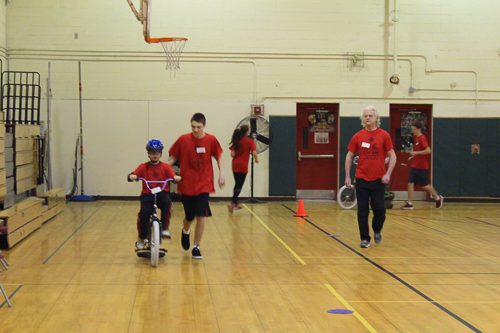
Safety for Pedestrians, Cyclists and Drivers
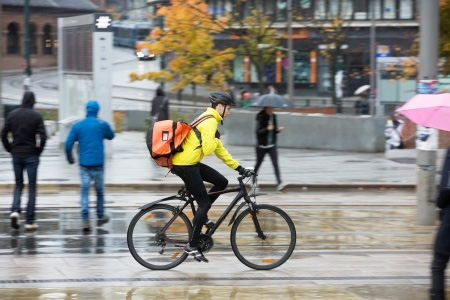 Safety for pedestrians and drivers was in the spotlight this winter, as Boston endured a record snow fall and everyone stood divided by the tallest of snowbanks. Now, as the snow starts to melt, cyclists are back out too and we want to take a moment to share a few safety reminders.
Safety for pedestrians and drivers was in the spotlight this winter, as Boston endured a record snow fall and everyone stood divided by the tallest of snowbanks. Now, as the snow starts to melt, cyclists are back out too and we want to take a moment to share a few safety reminders.
Safety was a priority this winter because Massachusetts saw many car accidents, even though state officials called multiple snow emergencies, and many schools closed, to keep the roads clear. We also saw at least two fatal pedestrian accidents. In Weymouth, a woman was hit and killed by a snow plow as she walked in the parking lot of her condominium complex. A 60-year-old employee at a Medford Whole Foods store also was killed, hit by a snow plow in the parking lot, leaving after his work shift.
Safety advocates made progress on protecting cyclists and pedestrians in 2014. This will serve as a strong foundation as we dig out from this harsh winter. In Boston, the city has implemented a truck safety ordinance, requiring that city-contracted trucks use sideguards and other protections aimed at protecting pedestrians and cyclists.
MassBike and other safety advocacy groups have also proposed new legislation which may get attention after this hard winter. If passed, the Bike Lane Protection Bill would make it illegal to block established bike lanes. The Vulnerable Road Users Bill would define pedestrians, cyclists, emergency personal and others as vulnerable road users and define a safe-passing distance for them.
Here are a few safety tips and facts to remember for pedestrians, cyclists and drivers:
Pedestrians
- Pedestrian accidents are too common. On average, in 2013, a pedestrian was killed every two hours and injured every eight minutes in traffic crashes, according to the National Highway Traffic Safety Administration (NHTSA).
- Walk on the sidewalks whenever possible. If a street only has sidewalks on one side, cross over.
- If you have to walk on the street, walk so you are facing oncoming motor vehicle traffic. Walk as close as you can to the curb to increase the space between you and traffic.
- Use crosswalks whenever they are available.
- Limit use of cell phones, iPods and music players.
- A common misperception is most pedestrian accidents happen at intersections. That is not true. Some 69 percent of pedestrian accidents occurred at non-intersections in 2013, according to the NHTSA.
- Some 10 percent of pedestrian accidents happened off the road, in areas such as parking lanes/zones, bicycle lanes, shoulders/roadsides, driveway access and similar areas.
- In the Spring of 2013, most pedestrian fatalities, 25 percent, occurred between 9 to 11:59 p.m., according to the NHTSA. Another 22 percent occurred between 6 to 8:59 p.m.
- If you walk at night, purchase a neon glow vest so you stand out to traffic. Even if you never wear it, it pays to be prepared.
Bicyclists
- Wear a bike helmet which meets the safety standard of the Consumer Product Safety Commission and properly fits.
- Cyclists follow different rules than pedestrians. Go with the flow of traffic, traveling in the same direction as cars, on the right side of the road. Up to two cyclists can ride in the middle of the traffic lane abreast if necessary to stay safe, but you should move back onto the side of the road single file when you can safely do so.
- State law prohibits biking on sidewalks in business districts. Not every city and town has a designated business district. But assume you are not allowed to ride on the sidewalk or ask the local police department for guidance.
- Cyclists must use hand signals to communicate to drivers, unless it would be unsafe to do so. You can view this video to learn the proper hand signals. Cyclists should also use a bell to let pedestrians know they are approaching.
- Watch out for dooring. This is when a car parks and the driver opens their door and hits you as you pass through. It is against the law, but it happens often.
- You are required to use a white headlight and red taillight or rear reflector if you ride anytime from a half hour after sunset until a half hour before sunrise.
- If you ride at night, consider purchasing a neon safety vest or clothing so you are more visible drivers..
- If you are involved in a bicycle accident, file a police report, even if you do not think you are seriously injured at first.
- Many drivers may not stop after cycling accidents. If you are hit and the driver does not stop, immediately contact police and file a police report.
Motor Vehicle Drivers
- Look for cyclists and pedestrians at every intersection and yield to them.
- Drivers must pass bicyclists at a safe distance. If you cannot, you must wait until it is safe to do so or change lanes.
- Obey all traffic laws and signals. Look for areas designated as school zones. Reduce your speed and take extra care on these roads.
- Do not park in bike lanes.
- Do not use your cell phone in the car. It is against the law in Massachusetts for drivers to text and drive, but the best practice is not to use it for telephone calls or other reasons either. It only takes a few seconds to cause a distracted driving car accident.
- A very dangerous practice is dooring. This is when a driver parks their car and opens the door without looking and hits an oncoming cyclist. It is against the law and violators can be fined. But drivers may also face a steeper penalty, a personal injury lawsuit, because cyclists can be seriously injured and the injuries can require months of recovery and hospital bills.
More Cycling Safety Resources
These are just a few rules of the road. To learn more, visit:
Shifting Gears: Bicyclists and Public Safety. Produced by MassBike, the Massachusetts Department of Public Health and the Boston Police Department.
Bike Safety in Massachusetts, Breakstone, White & Gluck.
What Every Massachusetts Bicyclist Needs to Know About Car Insurance, Breakstone, White & Gluck.
Somerville, Cambridge and Boston Are Among the Top U.S. Cities for Bike Commuters, Report Says
The City of Somerville will finish 2014 out front among cyclists. But Cambridge, Boston and Newton are close behind.
The League of American Bicyclists recently recognized Somerville as the Top Bike Commute City in the East. In Somerville, 7.8 percent of people now commute by bike, a larger share than anywhere in the East, including New York City or Philadelphia. In Massachusetts, Cambridge, Boston and Newton also made the Top 20 list.
The League of American Bicyclists’ calculated the figures based on U.S. Census Bureau Statistics, taking into account a city’s population and number of cyclists. The League of American Bicyclists concentrates on counting everyday bike commuters who ride as their primary mode of transportation, not those who only commute a few days a week or those who ride bikes to other transit.
Nationwide, Somerville reported the fifth highest share of bike commuters. Davis, California had the largest share, with 24.5 percent. Boulder, Colorado was second with 11 percent.
In the East, Cambridge came in a close second to Somerville, counting nearly 6.5 percent of residents as bike commuters. Combined, the two neighboring cities have a population of 186,090 and 7,467 bike commuters.
Still Boston is the larger city, with nearly 645,000 residents, and has the highest number of actual bike commuters in the region. It was listed seventh on the American League of Bicyclists’ list, with nearly 2 percent of residents counted as bike commuters. This works out to roughly 6,660 people. Among U.S. cities, Boston is the ninth fastest growing spot for cycling, with commuters up 122 percent from 1990 to 2013.
Cycling is also growing across Massachusetts. The number of people commuting by bike here has increased over 100 percent since 2005, compared to 46 percent for the average U.S. state. We are eager to see what 2015 brings.
Cycle Tracks For Somerville, Cambridge and Boston
We expect to learn a lot more about cycle tracks in 2015. Boston and Cambridge both have cycle tracks, which go a step beyond traditional bike lanes and separate cyclists from traffic with curbing, shrubbery or flexposts. Many bike advocacy groups see these as a critical tool in reducing bike accidents and injuries.
Somerville is planning cycle tracks along Beacon Street, through to the Cambridge border. In recent years, the state Department of Transportation has reported the highest number of bicycle accidents in Massachusetts in this area.
Cambridge was one of the first communities in the country to build a cycle track and now has one on Vassar Street and Concord Avenue from the Alewife Brook Parkway to Blanchard Road. The recent Western Avenue reconstruction project plans also incorporated a cycle track, as well as special bicycle traffic signals.
Boston built cycle tracks on Western Avenue and Commonwealth Avenue. The city’s 5-year action plan calls for the construction of 21 miles of cycle tracks. High priority areas include the streets around the Boston Public Garden, Boylston Street in Back Bay and Malcolm X Boulevard and Massachusetts Avenue in Roxbury.
Hubway. We are always watching to see what comes out of Hubway. The City of Boston launched the popular bike share program in July 2011 and each year it has expanded and gotten residents, workers and visitors excited about cycling (and encouraged bike helmet use, which is important). The program now has 1300 bikes at 140 stations in Boston, Somerville, Cambridge and Brookline, more than doubling its original size in just a few years. Many stations have closed down for the winter, except in Cambridge. But we will watch for the bike program next Spring.
Boston Truck Ordinance. A few weeks ago, the Boston City Council approved a truck safety ordinance requiring city-contracted trucks to be outfitted with side guards, convex mirrors and blind-spot awareness decals. This first-in-the-nation measure was passed to reduce pedestrian and cycling accidents. Many locally and nationally are watching as the city begins enforcement.
Community Bike Programs. Boston has an active network of cycling groups and committees. If you are a cyclist, we encourage you to seek one out in 2015 or attend an event at Bay State Bike Week in the spring. Here is a list.
Bike Helmet Donations. Watch for us in 2015 too. Breakstone, White & Gluck will again partner with local organizations and committees to donate bike helmets to local children. In 2014 we donated over 2,000 helmets to kids and programs around the state. 2015 will be our third year of making these donations through Project KidSafe, our community service program. Read about our partners.
Related:
“Where We Ride,” American League of Bicyclists.
Read More
Report: Helmet Use Encouraged After Increase in Cyclist Deaths
 After years of decline, a new report reveals that there has been an increase in the number of cyclists killed in motor vehicle accidents since 2010.
After years of decline, a new report reveals that there has been an increase in the number of cyclists killed in motor vehicle accidents since 2010.
The Governors Highway Safety Administration (GHSA) released the, “Spotlight on Highway Safety: Bicyclist Safety” report on Oct. 27th. The report shows cycling deaths have increased 16 percent from 2010 to 2012, from 621 to 722 cyclist fatalities. During that time, Massachusetts saw the numbers almost double, from seven cyclist deaths in 2010 to 15 in 2012. The majority of cyclist deaths came from six states, including California, Florida, Illinois, New York, Michigan and Texas.
During this period, other deaths in motor vehicle accidents increased by just one percent.
Two thirds or more of cyclists killed in 2012 were not wearing bike helmets, “a major contributing factor” in deaths because many cyclists suffer serious head injuries, the GHSA said.
More details from the report:
Bike helmet use. Citing 2012 Fatality Analysis Reporting (FARS) data, the GHSA report showed 65 percent of cyclists who died in 2012 were not wearing a bike helmet. Meanwhile, just 17 percent of cyclists were confirmed to be wearing one. Helmet use was unknown for the remaining 18 percent.
Twenty one states, including Massachusetts, have laws mandating bike helmet use for children. But none requires helmet use for adult riders and the GHSA said use has to be encouraged.
In Boston, city officials have raised the idea of mandating bike helmet use. It would not be the first city to do so. Sykesville, Maryland requires cyclists of all ages to wear bike helmets. But such ordinances are largely controversial. Dallas, Texas passed a law mandating helmets for all ages, but city officials revised it this summer, limiting it to cyclists who are 17 and under.
As it stands in Boston, riders of the Hubway bike share must agree to wear bike helmets when they sign up. The City of Boston has actively promoted bike helmet use over the years through advertising campaigns and community outreach programs.
Breakstone, White & Gluck has also worked to increase bike helmet use among children in Massachusetts. Over the past two years, we have donated 3,000 bike helmets through community organizations. We are proud of this work and will be back in 2015.
Our program partners include: Boston Bikes’ Roll It Forward, a program run by the City of Boston, Worcester Earn a Bike, CYCLE Kids, Cambridge Public Schools, Somerville Public Schools, Bikes Not Bombs, Framingham Bicycle and Pedestrian Committee, East Arlington Livable Streets and Arlington Public Schools, Watertown Bicycle and Pedestrian Committee, Westborough Bicycle and Pedestrian Committee, Somerville Kiwanis, Dedham Bike Rodeo, Boston Cyclists Union, Arlington Town Day, Westwood Bicycle and Pedestrian Committee, Lexington Bicycle Advisory Committee and the Ashland Farmer’s Market and iCan Shine Camp of Arlington.
State safety efforts. The GHSA touched on safety improvements which communities can make and strongly encouraged development of cycle paths. These go a step further than traditional bike lanes and physically separate motor vehicle traffic from cyclists on the road with flexible posts or other safety measures.
If communities cannot add cycle paths, the GHSA suggests adding marked bike lanes, bike boxes which designate space in a lane for bikes at intersections, and separate bike traffic signals with advance lights for cyclists.
Boston has a 5-year action plan to build 21 miles of cycle tracks in various areas of the city.
Read the full report, “Spotlight on Highway Safety: Bicyclist Safety.”
Read More
Boston City Council Passes Truck Side Guard Ordinance
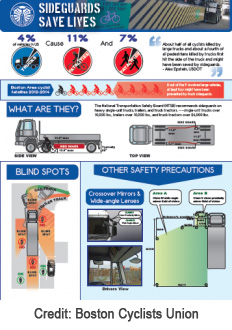 The Boston City Council has passed the Truck Side Guard Ordinance, the first of its kind in the nation. The ordinance will require side guards, convex mirrors, cross-over mirrors, and blind-spot awareness decals on all city-contracted vehicles over 10,000 pounds (or for tractor-trailer trucks with a combined weight over 26,000 pounds).
The Boston City Council has passed the Truck Side Guard Ordinance, the first of its kind in the nation. The ordinance will require side guards, convex mirrors, cross-over mirrors, and blind-spot awareness decals on all city-contracted vehicles over 10,000 pounds (or for tractor-trailer trucks with a combined weight over 26,000 pounds).
This ordinance passed quickly and unanimously last week. Mayor Martin J. Walsh, At-Large Boston City Councilor Ayanna Pressley and the Boston Cyclists Union, a non-profit advocacy group, filed the proposed ordinance on September 9th; it was approved by the council on Oct. 29th. It takes effect 180 days after passage and applies to all future contracts.
Side guards are meant to reduce injuries to drivers, cyclists and pedestrians by closing off the space under a truck. The National Transportation Safety Board recommended a side guard protocol last April, reporting that large truck side impacts comprised of 15 percent of fatal two-vehicle collisions between large trucks and passenger vehicles in 2011. In the United Kingdom, mandated side guards on large trucks reduced cyclist deaths by 61 percent and serious injuries to cyclists by 13 percent, according to a Transport for London study.
Boston’s goal is to protect cyclists, pedestrians and other drivers, but cyclists have faced especially hard road conditions in recent years. Since 2010, 11 cyclists have been killed in Boston, seven in bike accidents which involved a truck or bus, according to city figures. Injuries to cyclists from other causes have also increased, even though the city has developed Boston’s cycling infrastructure dramatically in recent years. The City continues to expand bike lanes and to work on cycle track projects which will put a physical barrier between cyclists and traffic.
Others may soon follow Boston in passing a truck side guard ordinance. Lawmakers in New York have proposed legislation that would mandate side under-ride guards on trucks, tractors, tractor trailers and semi-trailers. In Massachusetts, Somerville, Cambridge and Newton are also considering ordinances. Elsewhere, Portland and Washington D.C. also have proposed legislations or restrictions.
A few additional points:
Pilot Program. Boston began looking at truck side guards in 2013, when the Mayor’s Office of New Urban Mechanics and the city’s Public Works Department undertook a municipal pilot study of truck side guards.
Inspection. Vehicles associated with an awarded city contract will be inspected for side guards by the Inspectional Services Department and issued a permit, certifying the vehicle for 2-years.
Enforcement. Businesses will face a fine for vehicles which are not in compliance. The fines start at $100 for the first offense and rise with repeated violations to potential contract termination. The Boston Police Department will assist with enforcement.
Other City Offices. The Boston Transportation Department and Boston Bikes will assist with education, content expertise on best practice and as the point of contact for constituent reporting.
Exemptions. There are some exemptions, such as for trucks which are used exclusively for snow plowing or emergency vehicles.
Read more about Boston’s new truck ordinance.
About Breakstone, White & Gluck
The Boston personal injury lawyers at Breakstone, White & Gluck have over 100 years combined experience representing injured cyclists and pedestrians. For a free legal consultation, visit 800-379-1244 or 617-723-7676 or use our contact form.
Breakstone, White & Gluck Donates 150 Bike Helmets for Children in Westwood
Westwood families received free bike helmets for their children and learned about cycling and pedestrian safety at Westwood Town Day on September 27th.
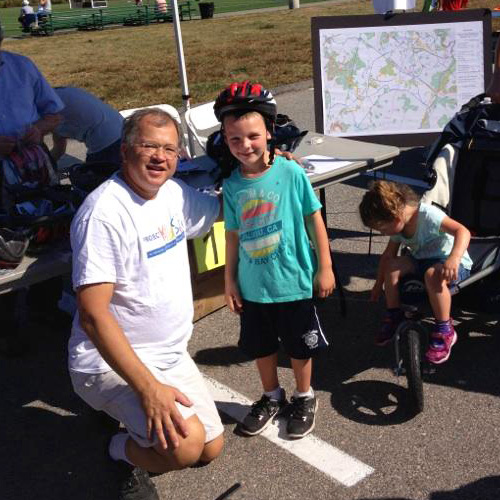
The Westwood Pedestrian and Bicycle Safety Committee hosted an informational table at the town celebration which was held at the Westwood High School. Breakstone, White & Gluck donated 150 bike helmets which were distributed to children age 16 and younger. The helmets went quickly at the annual event, which offers a fireworks display, music, food and road races for adults and children over the course of two days. Committee members fit children for the bike helmets and explained the importance of always wearing them. Attorney David White, a Westwood resident and committee member, helped fit the helmets.
In Massachusetts, children age 16 and younger are required by law to wear bike helmets. Cyclists of all ages should wear helmets to protect themselves and reduce the risk of head and brain injuries. Many cyclists neglect to do this. In fact, less than half of all cyclists actually wear helmets, according to the Centers for Disease Control and Prevention.
Breakstone, White & Gluck donated the helmets as part of Project KidSafe, our community service project to help prevent injuries among children. Our firm’s specialty is handling personal injury cases for those who have been injured, so we know firsthand the importance of injury prevention. We are devoted to keeping children safe. This is the second year we have donated bicycle helmets to organizations around the state. So far, we have donated over 2,000 helmets.
Read More
Boston Mayor Proposes New Truck Safety Ordinance
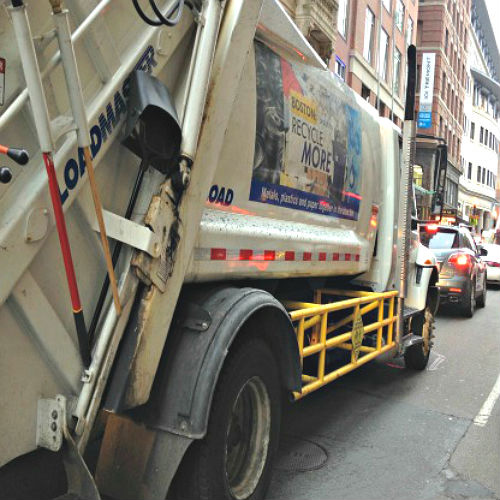
Mayor Marty Walsh is proposing a new safety ordinance for city-contracted trucks in Boston, a measure being widely watched after several cyclists have died in truck crashes. It is believed to be the first such ordinance in the nation.
Walsh, who took office in January, submitted an Ordinance to Protect Vulnerable Road Users to the Boston City Council earlier this week. The City Council was expected to take it up today in session.
If passed, the ordinance will require side guards, convex mirrors, cross-over mirrors, and blind-spot awareness decals on all vehicles over 10,000 pounds which are contracted with the city. The goal is to prevent truck accidents by giving drivers a better view around them. When trucks do not comply, fines start at $100 for the first offense and contracts can ultimately be terminated.
The Boston Cyclists Union called for these measures after a cyclist was killed in a Charlestown truck accident in April. It has released a fact sheet, “Safeguards Saves Lives.” According to the fact sheet, 4 percent of vehicles in the U.S. are trucks though they cause 11 percent of all bicyclist fatalities and 7 percent of all pedestrian fatalities.
Since 2010, 11 cyclists in Boston have died as a result of motor vehicle crashes, according to figures cited by Boston Magazine. Seven cases involved trucks. Here is another concerning figure: From 2009 to 2012, there were 1,700 confirmed cyclist incidents documented by Boston EMS emergency medical technicians and paramedics.
The City of Boston has been working on truck safety. Last year, the city began a pilot program, the largest in the nation. The Mayor’s Office of New Urban Mechanics and the city’s Public Works Department tested three different types of guards on 16 active vehicles driving the streets.
In April, the National Traffic Safety Board made similar recommendations to prevent tractor-trailer accidents.
About Breakstone, White & Gluck
The Boston personal injury lawyers at Breakstone, White & Gluck have over 100 years combined experience representing injured cyclists and pedestrians. We support efforts to make the roads of Boston safer and donate bike helmets for children each year, in Boston as well as Cambridge and Somerville and other communities. For a free legal consultation, visit 800-379-1244 or 617-723-7676 or use our contact form.
Massachusetts Lawyers Weekly Features Breakstone, White & Gluck’s Bike Helmet Donations
Breakstone, White & Gluck was recently mentioned in Massachusetts Lawyers Weekly for our bike helmet donations to children and for attorney David White’s “Volunteer of the Year” award from Boston Bikes, a program of the City of Boston.
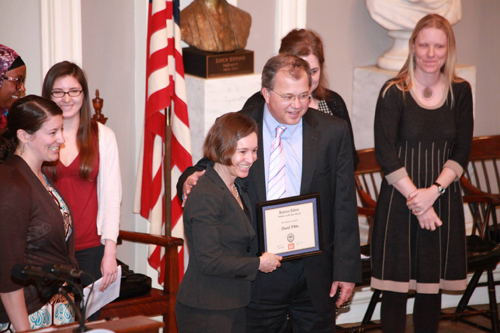 Photo credit: LivableStreets/www.livablestreets.info. Attorney David W. White of Breakstone, White & Gluck and Nicole Freedman, Director of Boston Bikes, during the 6th Annual Boston Bike Update at Faneuil Hall.
Photo credit: LivableStreets/www.livablestreets.info. Attorney David W. White of Breakstone, White & Gluck and Nicole Freedman, Director of Boston Bikes, during the 6th Annual Boston Bike Update at Faneuil Hall.
Read More

